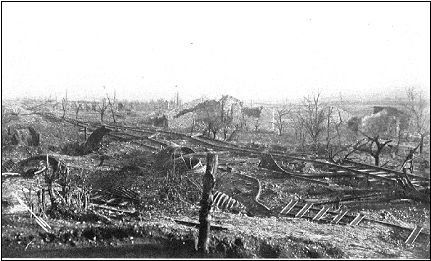
THE TAKING OF BANTHEVILLE AND HILL 270
View of village of Bantheville, showing the results of heavy shelling,
first by American artillery and later by the Germans.
THE mission assigned the 179th Brigade was achieved by the 1st and 3d Battalions of the 357th Infantry.
To the 1st Battalion was assigned the principal role. The commanding officer, Major Aubrey G.
Alexander, received his orders at the brigade P. C. after midnight of October 22-23, and rushed back to
his own P. C. to move his battalion under cover of darkness to their jumping-off place in the Bois de
Chauvignon, a kilometer and a half southwest of Bantheville, in the sector of the 89th Division. By
starting from this position it was hoped to avoid the losses which a long advance across the open north
of Romagne would naturally involve. From this position the 1st Battalion was to advance, first due
north, cleaning out the sunken roads which ran into Bantheville from the west, and also the enemy
machine gunners who were still believed to be lurking in the Bois de Bantheville. Having reached the
sunken road, Company D was to veer to the right, mopping up Bantheville, then turning again to the left
to take Hill 270 in flank. The 3d Battalion was to jump off from its trenches and advance north, taking
Bourrut and connecting with the 3d Battalion of the 358th Infantry.
The affair started at 3 P. M., after thirty minutes’ artillery bombardment of Bantheville and
Bourrut. Bantheville was soon taken, together with a machine gun and the crew left to delay the
American advance. But on leaving the town, Company D was forced to pass through a heavy barrage.
Undaunted, they made their way through the curtain of fire, turned aside to clean up some machine gun
nests in Bourrut which were holding up the 3d Battalion, and reached the objective. Captain Beauford
H. Jester had been badly gassed during the attack, but remained with the company.
The total casualties from this affair were only about twenty. The 3d Battalion suffered the
heaviest. Captain Harry E. Windebank was killed by shell fire: Lieutenant C. W. Paine, Company I, was
knocked down and slightly injured by high explosive; and Lieutenant E. C. Martin, Company I, was
saved only by his helmet, a fragment piercing the steel and entering his head.
The regimental 37-mm, platoon was able to render valuable assistance in this attack by firing on
machine gun emplacements. The trench mortar platoon followed up the infantry, and remained to